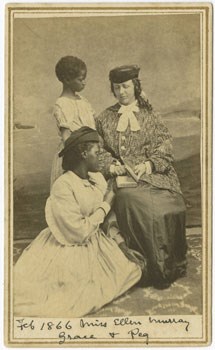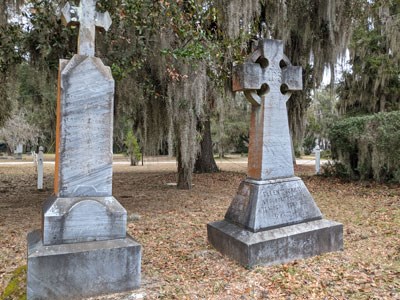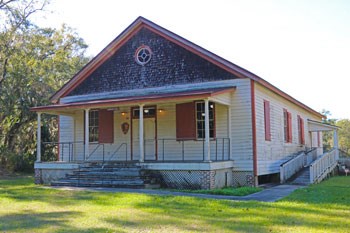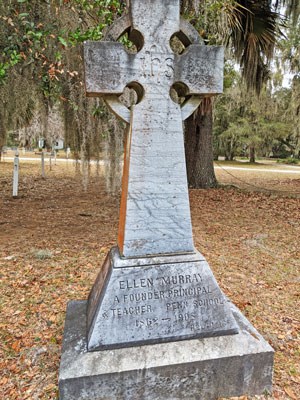Last updated: January 5, 2026
Article
Penn School's Founders at Rest

Penn Center Collections
The Port Royal Experiment was in its infancy when missionaries, doctors, and teachers traveled to Beaufort County in the Spring of 1862. During the previous Fall, Union forces established a foothold in Port Royal Sound, allowing for the foundation of schools, hospitals, and communities for the formerly enslaved people of Beaufort County and surrounding areas. Among the first to arrive on behalf of the Port Royal Relief Committee were two teachers and philanthropists from Philadelphia, Laura M. Towne and Ellen Murray. These women successfully established what would come to be known as Penn School - the first educational institution of its kind established for freed people in the Reconstruction Era South. Charlotte Forten, the school's first African American educator, would join the duo in the Fall of 1862.
Laura Towne and Ellen Murray were fortunate enough to see the fruits of their labor flourish throughout the latter half of the 19th century and spent the remainder of their lives in the South Carolina Lowcountry. There is no shortage of documentation regarding the work and success of Penn School's founders, however, the details regardingthe end of their lives is covered in few resources. Charlotte Forten, due to failing health, effectively resigned in 1864, but maintained an influence on her students, fellow faculty members, as well as the community, long after her service at Penn School. She died on July 23, 1914 and was buried in Harmony Memorial Park in Washington, D.C., however, a stone was erected in her memory near the entrance to Brick Baptist Church later in the 20th century. It had long been assumed that the final resting place for Towne and Murray was in Philadelphia's Laurel Hill Cemetery where most of Towne's family is buried, and that the markers which bear their names in Brick Baptist Church Cemetery were erected as memorials in the early 20th century - this is partially true.

NPS/C. Barr
With Towne's passing in February 1901, Penn School's operations fell on the shoulders of Ellen Murray along with the help of members of Virginia's Hampton Institute. Towne's legacy, however, impacted the people of Saint Helena Island deeply, as evidenced by a tall cenotaph which reads: "Erected by the people of St. Helena in memory of Laura M. Towne. Entered Into joy St. Helena, S.C. 1901. Their beloved and venerated teacher,Friend, helper, and Physician for forty years." On February 22, a 75-year-old Towne passed away at her Frogmore Plantation home. Following Towne's death, according to the February 23 edition of the Palmetto Post, "An embalmer came over from Charleston and embalmed the remains and placed them in a handsome metallic casket. The remains were brought to Port Royal . .. and placed aboard the afternoon train and taken North for interment."1 Just four days later, on February 26, Laura Matilda Towne was buried with her family in Pennsylvania.
Although her longtime friend and philanthropic partner had passed on, Ellen Murray remained a resident of Saint Helena Island for the rest of her life, and continued her dedicated service as a teacher until near her dying day on Tuesday January 14, 1908. The January 16 edition of the Beaufort Gazette in fact reported, "...Miss Murray after a few days of absence on account of an apparently slight illness was again in the schoolroom on, Monday, the day before she died, it may be said that her often expressed wish was fulfilled, that she might die in the harness ... Friends often urged that she should write the story of the work of Miss Towne and herself in Penn School, but she was too modest about herself, and too devoted to her work of teaching to leave it for anything else."2

NPS/Teodorski
The burial service for Ellen Murray was held on January 17 at a place that had been her home since she arrived in Beaufort County nearly 46 years earlier - the campus of Penn School. Before being laid to rest "beneath a wide spreading oak tree near the brick church ... ," Murray's memory was honored by students, family, friends, and community members at Darrah Hall. As chronicled nearly a week after the service:
"The burial service was held in Darrah Hall and conducted by the Rev.]. W. Sparks, Rector of St. Helena, Beaufort. The body lay in state on the floor of the large hall at the foot of the platform, which was decked with evergreens. The people being marshalled by Mr. Wilkins, entered by a side door passing the casket and took their seats quietly and in order. The hall was soon filled with people who flocked to pay the last honors to their friend and benefactress. Relatives, associates, and other friends, ladies and gentlemen of the island were present on the front seats. The solemn services of the Episcopal church, of which Miss Murray was a life long member, was participated in and listened to with marked attention by the large congregation, numbering, perhaps, eight hundred. A select choir of the teachers in the school rendered the hymns 'Jerusalem the Golden' and 'Peace Perfect Peace,' reverently and effectively. At the committal service, all stood, and Mr. Wilkins scattered earth on the coffin, at the words 'Earth to earth, etc.' . .. After the benediction the casket was carried to the grave, where ·spirituals' and hymns were sung by the people, and an address to them was made by the minister of the brick church: and thus was laid to rest the body of that devoted woman, among those people for whose instruction and upbuilding she had spent her life on St. Helena Island."3

NPS/Barr
While these founders of the Penn School were physically separated in death, their memories and legacy live on to this day and are remembered through stone and story. Ellen Murray's final resting place in the Brick Baptist Church Cemetery is marked with a memorial cenotaph which reads, "Ellen Murray - A Founder, Principal, Teacher, Penn School 1862-1908, Rev. 14. 13." Her stone, as well as Laura Towne's, now overlook the site of their life's work.
Written by Park Ranger Rich Condon, December 2020
Special thanks to the staff at the Beaufort County Library for their assistance in researching the historic newspaper collections, as well as to the staffs and Penn Center and Brick Baptist Church for their support.
Sources:
1"Miss Laura Towne - Death of a Friend to the Negroes," Palmetto Post, February 22, 1901.
2 "St. Helena's Veteran of Forty-Five Years Service," Beaufort Gazette, January 16, 1908.
3 "Funeral Services of Miss Ellen Murray," Beaufort Gazette, January 23, 1908.
